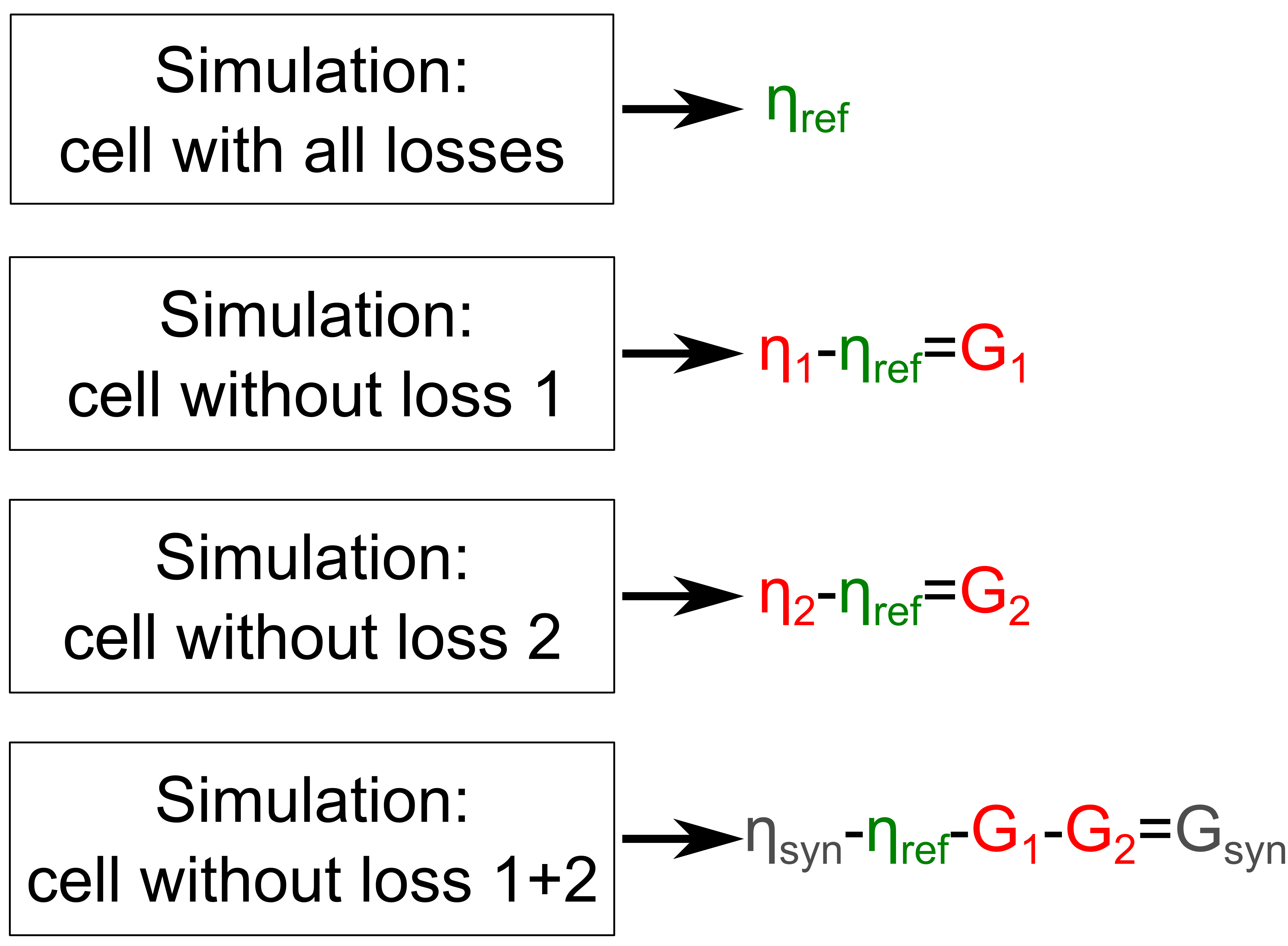SEGA GUI
In the research of industrial silicon solar cells the gap to the theoretical efficiency limit of about 29% closes gradually. State-of-the-art industrial PERC cells achieve efficiencies around 22% leaving only 7% efficiency improvement potential. Closing this gap further is a challenging task for cell developers. The identification of the most promising cell properties for the further research is an important aspect of the development process. The SEGA-GUI, which can be downloaded below, addresses this task by enabling researchers to perform synergistic efficiency gain analyses (SEGA) without any programming knowledge and on short timescales. Here the solar cell is simulated one time with the parameter as in a reference simulation and one time with the parameter idealized. The difference of the energy conversion efficiencies is the improvement potential due to this parameter. This approach also enables the analysis of synergistic effects between different loss channels. Also partly deactivated loss channels can be analyzed. The input required for performing a SEGA is a set of easily measurable cell properties including resistances and recombination currents. The optical properties of the cell can be determined from a measured reflectance spectrum. The SEGA-GUI employs Quokka 2 by A. Fell to perform the necessary simulations. Quokka 2 and the corresponding resources can be found at:
https://www2.pvlighthouse.com.au/resources/quokka2/Quokka 2.aspx
The output of a SEGA simulation is a sorted list of options for higher efficiency. The result graphs are automatically created within the SEGA-GUI
In a synergistic efficiency gain analysis each gain is determined by the difference of simulated efficiencies with the loss channel activated and deactivated. In addition, synergies can be analyzed by simultaneously switching off multiple loss channels. Consequently a SEGA requires about 20 simulations for a complete analysis of the cell. The SEGA-GUI automatically performs these simulations by employing Quokka 2 and automatically analyzes the result files.
License agreements "SEGA-GUI”
The following provisions govern the use of the Matlab tool developed by the Institut für Solarenergieforschung GmbH, Am Ohrberg 1, 31860 Emmerthal, (hereafter; ISFH) to calculate efficiency gains potentials in silicon solar cells (hereafter: SEGA-GUI).
For downloading and subsequent use of the SEGA-GUI, the specification of the user data as well as the explicit approval to these provisions is required.
§ 1 Right of use free of charge
The user is granted the free, perpetual, non-exclusive, non-transferable and non-sublicensable right to use the SEGA-GUI within its intended purpose.
§ 2 Copyright / Notice on publication of results
2.1 The SEGA-GUI is protected by copyright. The property rights and copyrights remain fully with the ISFH.
2.2 The user agrees to refer to the authorship of the ISFH by means of a suitable reference when publishing results which have been created using the SEGA-GUI and which have been identified by the SEGA-GUI, for example: The results follow from the application of the ISFH's SEGA-GUI.
§ 3 Hardware requirements
The user shall ensure that the hardware requirements for the use of the SEGA-GUI are met.
§ 4 Exclusion of Warranty
4.1 Support does not take place. There is no entitlement to updates or the like.
4.2 Despite conscientious creation and testing of the SEGA-GUI, the ISFH does not assume any warranty, in particular no warranty (i) for the correctness and/or completeness of the reported results and (ii) for the suitability of the SEGA-GUI and/or the reported results for a specific purpose.
The ISFH is not aware of any rights of third parties that prevent the use of the SEGA-GUI. The ISFH accepts no liability for the non-existence of such rights in the future.
§ 5 Liability
The liability of the ISFH for damages is excluded except in the case of intent and gross negligence and, except in the case of intent, limited to the foreseeable, typically occurring damage. Liability for culpable injury to life, limb and health shall remain unaffected by this.
§ 6 User data
The user agrees that his user data will be collected, processed and used to the extent necessary for the implementation of this contract (in particular for the maintenance of the existing rights of use). A transfer to third parties does not take place or only if the user has expressly agreed to it beforehand.
Insofar as the user data is personal data in accordance with the Federal Data Protection Act (BDSG), the provisions of the BDSG shall apply in addition, as far as relevant.
§ 7 Termination for good cause
The right to use the SEGA-GUI is unlimited (§ 1 sentence 1). However, the ISFH is entitled to terminate this contract with immediate effect for good cause, in particular if the user persistently violates secondary contractual obligations.
§ 8 Final provisions
8.1 The exclusive place of jurisdiction shall be Hanover, Germany.
8.2 Amendments and supplements to this contract must be made in writing.
8.3 Should any provision of this contract be or become invalid or should the contract contain a loophole, this shall not affect the legal validity of the remaining provisions. The invalid provision shall be replaced by a valid provision which comes as close as possible to the economic intent of the parties; the same shall apply in the event of a loophole.
8.4 This contract is subject to the law of the Federal Republic of Germany to the exclusion of international private law and the UN Sales Convention.



